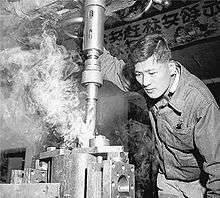Model worker
Model worker (Chinese: 劳动模范; pinyin: láodòng mófàn, abbreviated as 劳模 or láomó) is a Communist Chinese political term referring to an exemplary worker who exhibits some or all of the traits appropriate to the ideal of the socialist worker. The idea is similar to the Soviet Stakhanovite icon. Model workers are selected in China by central and provincial-level departments. Some cities and large companies also have processes for selecting and praising model workers.
The basic criteria for model workers are patriotism, "worship of science," activities in environmental protection, and the pursuit of excellence.
Model workers are often afforded privileges not available to other citizens or Communist Party members. "The possibility to become a model worker offered peasants and workers one of the few opportunities for upward mobility other than joining the army," writes scholar Yu Miin-lin.[1] Model workers have an easier time joining the Communist Party, and also to become a higher-level cadre, manager, or other leader.
Notable model workers

One of the earliest model workers was the teenage textile worker Hao Jianxiu (awarded 1951), who invented the "Hao Jianxiu Work Method". She was sent to study at East China Textile Engineering Institute and was elevated to the upper echelon of Chinese politics, serving as Minister of Textile Industry, secretary of the CPC Central Secretariat, and vice chair of the State Planning Commission.[2]

Another prominent model worker was Ni Zhifu (awarded 1959), a fitter who invented the "Ni Zhifu drill". He was elevated to leadership positions in the municipal governments of Beijing, Shanghai, and Tianjin, and became a member of the Politburo of the Communist Party of China. He also served as Chairman of the All-China Federation of Trade Unions.[3]
References
- ↑ Li & Bernstein, Hua-Yu & Thomas P. (2011). ""Labor Is Glorious": Model Laborers in the People's Republic of China". China Learns from the Soviet Union, 1949-Present (The Harvard Cold War Studies Book Series). Lexington Books. p. 254. ISBN 0739142232.
- ↑ Lee, Lily Xiao Hong; Stefanowska, A. D. (2003). Biographical Dictionary of Chinese Women: The Twentieth Century, 1912–2000. M.E. Sharpe. pp. 198–9. ISBN 978-0-7656-0798-0.
- ↑ 倪志福同志生平 [Biography of Ni Zhifu]. People's Daily (in Chinese). 3 May 2013.